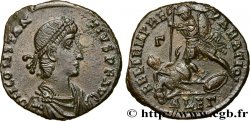v51_0221 - CARIE - CNIDE Tétradrachme
MONNAIES 51 (2011)
Начальная цена : 3 500.00 €
Назначить цену : 5 500.00 €
Цена реализации : 4 539.00 €
Количество ставок : 2
Максимальная предлагаемая цена : 5 500.00 €
Начальная цена : 3 500.00 €
Назначить цену : 5 500.00 €
Цена реализации : 4 539.00 €
Количество ставок : 2
Максимальная предлагаемая цена : 5 500.00 €
Тип Tétradrachme
Дата: c. 387-345 AC.
Монетный двор / Город: Carie, Cnide
Металл: silver
Диаметр: 26 mm
Ориентация осей монеты: 9 h.
Вес: 14,59 g.
Редкость: R3
Комментарии о состоянии
Exemplaire sur un flan large et ovale, parfaitement centré des deux côtés. Portrait magnifique de haut relief avec tous les détails de la chevelure visibles. Revers fantastique, bien venu à la frappe de très haut relief. Jolie patine de collection ancienne avec des reflets mordorés, légèrement granuleuse au droit. Conserve une partie de son brillant de frappe et de son coupant d’origine
Ссылки в каталоге: :
Происхождение:
Cet exemplaire provient du trésor d’Hecatomnus, de la vente Asta Cerisio I, 1987, n° 133 et de MONNAIES IX, n° 103
Лицевая сторона
Аверс: легенда: ANÉPIGRAPHE.
Аверс: описание: Tête d'Aphrodite Euploia à gauche, les cheveux relevés en arrière et retenus par un sphendoné ; derrière la tête, une proue de galère.
Аверс: легенда: K-NI
Аверс: перевод: (Cnide).
Обратная сторона
Реверс: Описание: Protomé de lion à gauche, la gueule ouverte, la langue pendante ; le tout dans les restes d'un carré creux.
Реверс: легенда: [K]LEOSQENHS
Реверс: перевод: (Kleosthénès).
Комментарий
Magistrat Kléosthénès. Même coin de droit que l'exemplaire du cabinet des médailles de Paris (pl.CXL, n°25) et mêmes coins que l'exemplaire de la vente Giesener Münzhandlung 48 (1990), n° 440. Notre exemplaire est illustré dans The Hecatomnus Hoard, CH. IX, Londres 2002, p. 119, n° 32a, pl. 12.
Magistrate Kleosthenes. Same obverse die as the example in the Paris medal cabinet (pl. CXL, no. 25) and same dies as the example in the Giesener Münzhandlung 48 sale (1990), no. 440. Our example is illustrated in The Hecatomnus Hoard, CH. IX, London 2002, p. 119, no. 32a, pl. 12
Magistrate Kleosthenes. Same obverse die as the example in the Paris medal cabinet (pl. CXL, no. 25) and same dies as the example in the Giesener Münzhandlung 48 sale (1990), no. 440. Our example is illustrated in The Hecatomnus Hoard, CH. IX, London 2002, p. 119, no. 32a, pl. 12








 Cообщить об ошибке
Cообщить об ошибке Распечатать страницу
Распечатать страницу Отправить мой выбор
Отправить мой выбор Задать вопрос
Задать вопрос Consign / sell
Consign / sell








